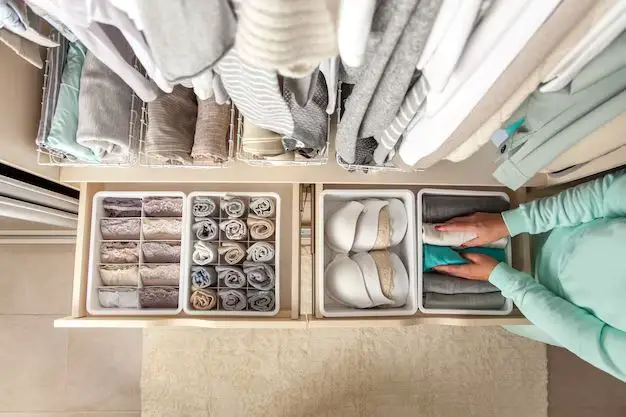Having an organized closet can make getting ready in the morning much easier and less stressful. For professionals who need to look polished and put together for work every day, taking the time to properly organize their closet space is a must. Here we will explore some tips and strategies used by professionals to keep their closets neat, tidy and functional.
Page Contents
Assess Your Needs
Before organizing your closet, take stock of what you currently have and determine what you actually wear versus what’s just taking up space. Analyze your lifestyle and identify your wardrobe needs. For example, do you need more space for office attire, exercise clothes, formal wear or weekend casuals? Do certain items, like shoes or accessories, need more room? Once you know what you use most, you can start editing and rearranging with your specific needs in mind.
Edit and Purge
Be ruthless and get rid of anything you don’t wear. This not only clears space but also makes what you do wear easier to find. Some editing tips:
- Try on clothes and be honest about what fits, flatters and is in good condition. Donate or consign what you don’t wear.
- Toss old underwear, socks with holes, ripped tights and other unwearable items.
- Check expiration dates on makeup and skincare and discard anything that’s expired.
- Get rid of hangers for clothes you’ve removed.
- Only keep one to two years’ worth of seasonal clothes.
- Clear out duplicate items and gifts you don’t like.
Be mindful not to over-purge – if you love an item but just don’t use it often, consider keeping it. Offload true excess to save space.
Categorize
Grouping similar garments together in your closet helps you locate items faster. Possible ways to categorize:
- Type: shirts, pants, dresses, coats
- Function: work, casual, formalwear, exercise
- Season: winter, summer
- Color: blacks, neutrals, brights
Use categories that make the most sense for your needs and preferences. Labeling categories with tags, signs or dividers can further delineate groups.
Use Organizing Tools
Strategically place common organizing tools to maximize your available space:
- Hanging storage: Use for dresses, coats, shirts and pants. Place commonly worn items at eye level for easy access.
- Shelving: Use for folded sweaters, jeans, T-shirts and accessories like handbags. Stack horizontally to see items easily.
- Drawers: Use for delicates, socks, underwear, pajamas. Use dividers to separate types.
- Shoe racks: Place on the floor or install hanging racks. Group shoes by function.
- Hooks: Install on walls or the back of doors to hang bags, belts, scarves and hats.
Optimize Hanging Space
Make the most of your hanging space with these tips:
- Only hang clothing that might wrinkle, like button-downs, dresses and pants. Fold non-wrinkle items like jeans and tee shirts.
- Face open hook ends of hangers towards you so clothes don’t slide off.
- Use slim, velvet hangers that slide easily along the rod but keep clothes smooth.
- Put two hangers facing opposite directions through each skirt to keep the hem even.
- Arrange clothes from light to heavy and short to long so you can see everything.
- Hang long dresses and coats on lower rack levels so they don’t drag.
Store Seasonally
Storing off-season clothing saves space and reduces clutter. Some tips:
- Use vacuum storage bags for bulky items like coats and sweaters.
- Pack items in labeled clear plastic bins you can stack and slide under beds.
- Only keep 1-2 of your most essential off-season items handy for unexpected weather.
- Swap out seasonal wardrobe boxes every 6 months when changing over your clothes.
Declutter Accessories
With small items like accessories, being organized is critical. Useful methods include:
- Store jewelry in a hanging organizer or divided drawers so items don’t tangle.
- Use trays or boxes for items like cufflinks, watches and sunglasses.
- Hang belts, scarves and ties on hooks or coat hangers.
- Stow purses upright on shelves so they don’t lose their shape.
- Use spinning carousels or tiered shelves to display folded scarves, gloves and hats.
- File hair accessories and products in shallow drawers.
Maintain With Habits
Keeping your organized closet clutter-free takes some regular habits:
- Put clothing back properly each use – don’t just toss items in.
- Do a quick straighten every week as you put away laundry.
- Edit seasonally before switching your wardrobe.
- Don’t let piles accumulate – put new purchases away immediately.
- Remove items you haven’t worn in over a year.
- Deep clean your closet thoroughly each season, donating unneeded items.
With consistent habits, just minor tidying efforts will enable you to sustain your system.
Conclusion
Organizing your closet effectively enables you to start your day smoothly, project a professional image and find joy in your space. Assess your needs, edit ruthlessly, utilize organizing tools, optimize hanging room and maintain with habits. A streamlined closet simplifies getting dressed for busy professionals who need to look their best.
